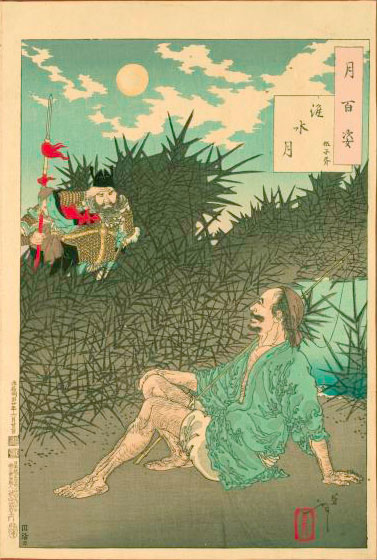About This Print
Late in his life, the Chinese general Wu Zixu avenged his father's death. A fisherman on the Huai River told him the location of the grave of his father's murderer. He found the grave, exhumed the body, and beat it as a punishment. This print is from the album issued by publisher Akiyama Buemon shortly after Yoshitoshi's death and retains its original album backing.The Story Depicted in the Print as Told by John Stevenson
Source: Yoshitoshi's One Hundred Aspects of the Moon, John Stevenson, Hotei Publishing, Netherlands 2001
48.Huai River moon – Wu Zixu
Waisui no tsuki – Goshishō
Yoshitoshi again reaches back into Chinese mythology for the story behind this print. An old Chinese play called Wu yuan rui xiao tells of an official named Wu Zixu who lived in the state of Chu shortly before the Warring States period of 48-222 B.C. The king of Chu killed Wu Zixu’s father and brother, and Wu fled to a neighboring kingdom. He helped its ruler conquer his own native Chu, on whose people he inflicted savage reprisals. During the campaign he was helped by a fisherman who ferried him across the river Huai.
Later Wu searched the banks of the river for the tomb of the king who had killed his father and brother. Again he was helped by a fisherman. He discovered the tomb, exhumed the dead king, and whipped it three hundred times in revenge for his murdered father and brother. In 493 B.C. Wu was implicated in a court intrigue and he was forced to kill himself – he died uttering a particularly blood-curdling wish, and his head was hung on the city walls. Two years later, the king who had invited him to commit suicide was overthrown. As the king was led outside the city to be executed, Wu’s grisly head slowly turned and grinned at him.
The title of the print states that its subject is the somewhat obscure Wu Zixu, but the design itself, a smiling fisherman with a rod, sitting at ease, being discovered by a high-ranking Chinese in military dress by the side of a river, suggests a much more popular story, that of the Daoist sage, Jiang Ziya. If the figure is Jiang Ziya, it would be satisfying in that it made the fisherman the subject of the print rather than the smaller military figure. The moon is incidental to both stories.
The second story goes as follows. One day, as the emperor Shi Bei prepared to go hunting, the court astrologer told him that he would catch, not a tiger or a bear, but a great statesman. When the emperor reached the river Wei, he found an old man sitting on the bank, using a straight nail for a hook and no bait. The old man explained that he was not particularly interested in catching fish, preferring to concentrate his mind on lofty moral matters, but that the fish came and impaled themselves on his nail anyway. With this proof of the man’s extraordinary virtue, the emperor took him back to the court to be his counselor. The man’s name was Jiang Ziya, Kyōshiga in Japanese. He served the emperor well for twenty years, then retired, dying in 1120 B.C. at the age of ninety. Jiang’s equanimity, his willingness to accept the flow of natural events, is often taken as the epitome of a proper Daoist attitude.
In the print a Chinese general catches sight of the ragged figure sitting with his bamboo fishing pole by the river. The fisherman laughs and does not seem surprised to see him. The general pushes through a bank of reeds – the drawing of the reeds is stiff and not entirely successful. Woodblock printing is a hard-edged medium, and it takes either careful drawing or imaginative techniques, such as different tones, to suggest the edges of soft or pliant substances. Contrast the reeds here with the vegetation of, for example, the fox prints.
Image from Publisher's Bound Album (Issued shortly after Yoshitoshi's death)
About the Series "One Hundred Aspects of the Moon"For details about this series which consists of one hundred prints with the moon as a unifying motif, see the article on this site Yoshitoshi, One Hundred Aspects of the Moon.
Print Details
| IHL Catalog | #332 |
| Title | Huai River Moon - Wu Zixu (Waisui no tsuki - Goshishō 淮水月 伍子胥) |
| Series | One Hundred Aspects of the Moon (Tsuki hyaku sugata 月百姿) |
| John Stevens Reference No.* | 48 |
| Artist | Tsukioka Yoshitoshi (1839-1892) |
| Signature | Yoshitoshi 芳年 |
| Seal | Taiso 大蘇 |
| Date | June 23, 1887 (御届明治廿年六月廿三日) |
| Edition | Likely from the album issued posthumously by the publisher. |
| Publisher | Akiyama Buemon (秋山武右エ門) [Marks: seal 26-132; pub. ref. 005] |
| Carver | Enkatsu tō 円活刀 [full name Enkatsu Noguchi] |
| Impression | excellent |
| Colors | excellent |
| Condition | excellent - backed, small discoloration center of left margin extending 1/4" into image |
| Genre | ukiyo-e |
| Miscellaneous | |
| Format | Oban |
| H x W Paper | 14 1/4 x 9 5/8 in. (36.2 x 24.4 cm) |
| H x W Image | 13 x 8 7/8 in. (33 x 22.5 cm) |
| Collections This Print | New York Public Library Humanities and SocialSciences Library / Spencer Collection Image ID 1269833; Yale University Art Gallery 2011.143.1.48; Tokyo Metropolitan Library 5233-60-37;The Tsubouchi Memorial Theatre Museum of Waseda University 401-0535; Ritsumeikan University ARC NDL-541-00-035 |
| Reference Literature | * Yoshitoshi’s One Hundred Aspects of the Moon, John Stevenson, Hotei Publishing, Netherlands 200, pl. 48. |




